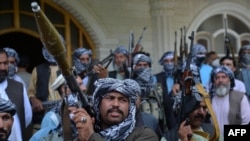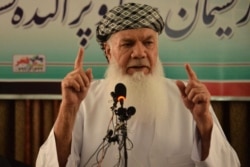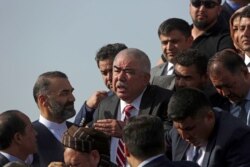The beleaguered Afghan government is having to turn to veteran warlords to try to fend off the Taliban as international forces withdraw from the country.
The warlords return to playing a major military role is a key part of President Ashraf Ghani’s national mobilization plan to halt the Taliban’s nationwide offensive but is raising fears that at best it will lead to Afghanistan splintering once again into dueling local fiefdoms, setting the stage for a prolonged and messy civil war, mirroring what unfolded in the 1990s after the Soviet withdrawal.
A former top British army commander General Richard Barrons, told the BBC Monday he fears the country will be plunged into a decades-long civil war and dubbed the decision to withdraw from Afghanistan a “strategic mistake.” “I don't believe it's in our own interest,” he said.
Abdul Rashid Dostum is among the old warlords returning to the fray as the Taliban gains more territory. More than a dozen cities are now under siege by the Taliban, including several provincial capitals.
The lightning offensive by the Taliban has rocked the Afghan government and unfolded in the wake of the decision by the Biden administration to withdraw U.S. troops from the country. Almost all NATO troops will be gone by September.
In Herat, the scene of heavy fighting, the defense of the city is being overseen by another veteran warlord, 70-year-old Mohammed Ismail Khan, a former mujahedeen leader against the Russians and the Taliban. His forces are estimated to comprise of 6,000 volunteers, some veterans from the civil war in the 1990s, according to Western military officials.
Afghan President Ashraf Ghani, who long vowed to clean out warlords, met with Dostum last week on his return to Afghanistan from Turkey, where the former army paratrooper and onetime U.S. ally was reported to be undergoing medical treatment.
Dostum is a former Afghan vice-president but currently holds no official government position. He was a key figure in the fight against the Taliban in the 1990s and has long been seen as one of Afghanistan’s most powerful but notorious warlords. His militia was accused by rights groups in the 1990s of rapes and massacres of prisoners.
Some Afghan experts are doubtful that the support of veteran warlords and their newly formed and revived militias will be sufficient to fend off the Taliban, unless the demoralized Afghan army pulls its weight more.
Among the doubters is Vanda Felbab-Brown, director of the Initiative on Non-state Armed Actors at the Brookings Institution, a think tank in Washington. She noted in a tweet Sunday that the Taliban has been notching up successes in areas where there are strong anti-Taliban militias which have been embraced by the Afghan government.
With Afghan soldiers and weapons in short supply, though, Western diplomats and analysts say the Afghan president has little option but to call for help from the veteran warlords he’s tried to keep at arm’s length in the past. They add that political factions, regional bosses and powerbrokers will start growing their militias even without the encouragement of the central government.
“As Taliban victories on the battlefield grow, all other factions will ramp up their efforts to build militias and create an opposing force to defeat them,” predict Annie Pforzheimer, a former acting deputy assistant Secretary of State for Afghanistan, and Nilofar Sakhi, who has been involved in the Afghan peace process since 2010.
In a commentary for the Middle East Institute, a Washington think tank, they said: “Expect regional powers to arm and supply money to their preferred factions and for the militias to keep switching sides and loyalties for gains that will further weaken the Afghan central government.”
Romain Malejacq, author of the book “Warlord Survival: The Delusion of State Building in Afghanistan,” foresees a similar outcome. “Whether the central government manages to hold its own and resist the Taliban or not, post-NATO Afghanistan is likely to feature a patchwork of overlapping, competing, political orders between the state, the Taliban, the warlords and other non-state armed actors — something resembling Afghanistan of the 1990s,” he wrote in paper for the Clingendael Institute, a Dutch international affairs think tank.








